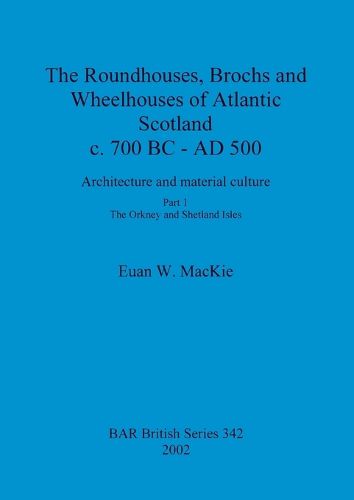Readings Newsletter
Become a Readings Member to make your shopping experience even easier.
Sign in or sign up for free!
You’re not far away from qualifying for FREE standard shipping within Australia
You’ve qualified for FREE standard shipping within Australia
The cart is loading…






This title is printed to order. This book may have been self-published. If so, we cannot guarantee the quality of the content. In the main most books will have gone through the editing process however some may not. We therefore suggest that you be aware of this before ordering this book. If in doubt check either the author or publisher’s details as we are unable to accept any returns unless they are faulty. Please contact us if you have any questions.
The Scottish broch - symbolized by the lonely tower on Mousa island in Shetland - has, since the early years of the 18th century, excited the curiosity of archaeologists, antiquaries, and lay persons alike. The great piles of rubble, or the green mounds covering their massive ruins (dated c.700 BC - AD 500), are everywhere to be seen in the western and northern islands and in the north-eastern counties of Caithness and Sutherland, often in upland places where there are few other signs of dynamic human habitation. Indeed, part of the fascination of the brochs is that these abundant signs of about 1200 years of human dynamic human energy and organization are concentrated in the maritime region of the far north and west of Scotland which, until the discovery of oil focused attention on the importance of the sea again, seemed remote in every sense from the centres of population of the modern UK. Most writers about brochs in the past have tended to rely for their conclusions on a relatively small number of well-known sites.Apart from the from the work of the Royal Commission on the Ancient and Historical Monuments of Scotland there has never been a systematic attempt to collate all the available data about brochs everywhere, and the finds made in them. This is one of the tasks the author set himself in 1961, soon after arriving in Scotland, and this volume is the first half of the result. This thorough study includes 329 illustrations, plans, photographs and maps, as well as an Index of site names and an Appendix of over 400 Iron Age artefacts drawn by author.
$9.00 standard shipping within Australia
FREE standard shipping within Australia for orders over $100.00
Express & International shipping calculated at checkout
This title is printed to order. This book may have been self-published. If so, we cannot guarantee the quality of the content. In the main most books will have gone through the editing process however some may not. We therefore suggest that you be aware of this before ordering this book. If in doubt check either the author or publisher’s details as we are unable to accept any returns unless they are faulty. Please contact us if you have any questions.
The Scottish broch - symbolized by the lonely tower on Mousa island in Shetland - has, since the early years of the 18th century, excited the curiosity of archaeologists, antiquaries, and lay persons alike. The great piles of rubble, or the green mounds covering their massive ruins (dated c.700 BC - AD 500), are everywhere to be seen in the western and northern islands and in the north-eastern counties of Caithness and Sutherland, often in upland places where there are few other signs of dynamic human habitation. Indeed, part of the fascination of the brochs is that these abundant signs of about 1200 years of human dynamic human energy and organization are concentrated in the maritime region of the far north and west of Scotland which, until the discovery of oil focused attention on the importance of the sea again, seemed remote in every sense from the centres of population of the modern UK. Most writers about brochs in the past have tended to rely for their conclusions on a relatively small number of well-known sites.Apart from the from the work of the Royal Commission on the Ancient and Historical Monuments of Scotland there has never been a systematic attempt to collate all the available data about brochs everywhere, and the finds made in them. This is one of the tasks the author set himself in 1961, soon after arriving in Scotland, and this volume is the first half of the result. This thorough study includes 329 illustrations, plans, photographs and maps, as well as an Index of site names and an Appendix of over 400 Iron Age artefacts drawn by author.